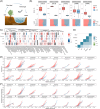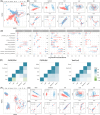Primer selection impacts the evaluation of microecological patterns in environmental microbiomes
- PMID: 38868223
- PMCID: PMC10989904
- DOI: 10.1002/imt2.135
Primer selection impacts the evaluation of microecological patterns in environmental microbiomes
Abstract
This study revealed that primer selection substantially influences the taxonomic and predicted functional composition and the characterization of microecological patterns, which was not alleviated by close-reference clustering. Biases were relatively consistent across different habitats in community profiling but not in microecological patterns. These primer biases could be attributed to multiple aspects, including taxa specificity, regional hypervariability, and amplification efficiency.
© 2023 The Authors. iMeta published by John Wiley & Sons Australia, Ltd on behalf of iMeta Science.
Conflict of interest statement
The authors declare no conflict of interest.
Figures



Similar articles
-
The Impact of Primer Design on Amplicon-Based Metagenomic Profiling Accuracy: Detailed Insights into Bifidobacterial Community Structure.Microorganisms. 2020 Jan 17;8(1):131. doi: 10.3390/microorganisms8010131. Microorganisms. 2020. PMID: 31963501 Free PMC article.
-
Fine-scale evaluation of two standard 16S rRNA gene amplicon primer pairs for analysis of total prokaryotes and archaeal nitrifiers in differently managed soils.Front Microbiol. 2023 Feb 23;14:1140487. doi: 10.3389/fmicb.2023.1140487. eCollection 2023. Front Microbiol. 2023. PMID: 36910167 Free PMC article.
-
Performance of 16s rDNA Primer Pairs in the Study of Rhizosphere and Endosphere Bacterial Microbiomes in Metabarcoding Studies.Front Microbiol. 2016 May 13;7:650. doi: 10.3389/fmicb.2016.00650. eCollection 2016. Front Microbiol. 2016. PMID: 27242686 Free PMC article.
-
Effects of Microecological Preparations on Obese Patients after Bariatric Surgery: A Systematic Review and Meta-Analysis.Evid Based Complement Alternat Med. 2020 May 31;2020:8724546. doi: 10.1155/2020/8724546. eCollection 2020. Evid Based Complement Alternat Med. 2020. PMID: 32595746 Free PMC article. Review.
-
Exploring the effect of microecological agents on postoperative immune function in patients undergoing liver cancer surgery: a systematic review and meta-analysis.Ann Palliat Med. 2021 Nov;10(11):11615-11627. doi: 10.21037/apm-21-2669. Ann Palliat Med. 2021. PMID: 34872286
Cited by
-
Asymbiotic Nitrogen Fixation in the Phyllosphere of Urban Green Spaces.Curr Microbiol. 2025 May 3;82(6):276. doi: 10.1007/s00284-025-04250-w. Curr Microbiol. 2025. PMID: 40319203
-
Insect Insights at the Single-Cell Level: Technologies and Applications.Cells. 2023 Dec 31;13(1):91. doi: 10.3390/cells13010091. Cells. 2023. PMID: 38201295 Free PMC article. Review.
-
Pathogenicity and host-interacting mechanisms of enterogenic Enterobacter cancerogenus in silkworm.Front Microbiol. 2025 Mar 26;16:1548808. doi: 10.3389/fmicb.2025.1548808. eCollection 2025. Front Microbiol. 2025. PMID: 40207159 Free PMC article.
-
Fitness effects of synthetic and natural diet preservatives on the edible insect Bombyx mori.NPJ Sci Food. 2024 Jun 22;8(1):39. doi: 10.1038/s41538-024-00284-9. NPJ Sci Food. 2024. PMID: 38909075 Free PMC article.
-
Improving the reporting of metagenomic virome-scale data.Commun Biol. 2024 Dec 20;7(1):1687. doi: 10.1038/s42003-024-07212-3. Commun Biol. 2024. PMID: 39706917 Free PMC article.
References
-
- Fischer, Martin A. , Güllert Simon, Neulinger Sven C., Streit Wolfgang R., and Schmitz Ruth A.. 2016. “Evaluation of 16S rRNA Gene Primer Pairs for Monitoring Microbial Community Structures Showed High Reproducibility Within and Low Comparability Between Datasets Generated With Multiple Archaeal and Bacterial Primer Pairs.” Frontiers in Microbiology 7: 1297. 10.3389/fmicb.2016.01297 - DOI - PMC - PubMed
-
- Li, Changchao , Jin Ling, Zhang Chao, Li Shuzhen, Zhou Tong, Hua Zhongyi, Wang Lifei, et al. 2023. “Destabilized Microbial Networks With Distinct Performances of Abundant and Rare Biospheres in Maintaining Networks Under Increasing Salinity Stress.” iMeta 2: e79. 10.1002/imt2.79 - DOI - PMC - PubMed
LinkOut - more resources
Full Text Sources
